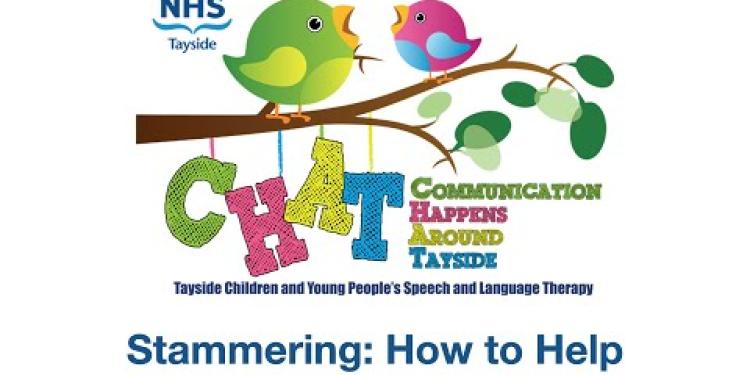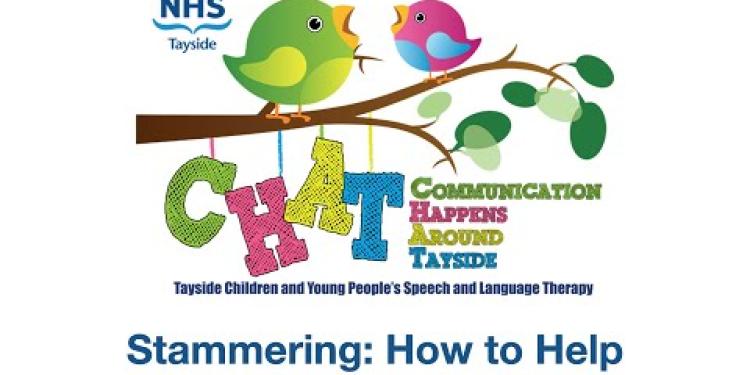Important Information On Using This Service
- Ergsy carefully checks the information in the videos we provide here.
- Videos shown by YouTube after a video has completed have NOT been reviewed by ERGSY.
- To view, click the arrow in the center of the video.
Using Subtitles and Closed Captions
- Most of the videos you find here will have subtitles and/or closed captions available.
- You may need to turn these on and choose your preferred language.
Turn Captions On or Off
- Go to the video you'd like to watch.
- If closed captions (CC) are available, settings will be visible on the bottom right of the video player.
- To turn on captions, click settings.
- To turn off captions, click settings again.
Find A Professional
More Items From Ergsy search
-

Stammering: myths about the cause of stammering
Relevance: 100%
-

Stammering myth 4: You should ignore a child's stammer
Relevance: 71%
-

Giving Voice - Stammer and Fluency Problems
Relevance: 69%
-

Why do some children stammer?
Relevance: 69%
-

Stammering: How to Help
Relevance: 60%
-

Adam's story on stammering - Therapy
Relevance: 59%
-

I don’t need to be fixed – what I wish the world understood about stammering
Relevance: 58%
-

Practical strategies to support young children who stammer
Relevance: 52%
-

My Stammering Child
Relevance: 51%
-

Will's story on having therapy - Stammering
Relevance: 44%
Practical Strategies to Support Young Children Who Stammer
Understanding Stammering
Stammering, or stuttering, is a speech disfluency that affects the flow of speech. It can manifest as repetitions, prolongations, or blocks in the production of sounds or syllables. It's important to recognise that stammering is not a reflection of a child's intelligence or capabilities. Understanding this can help in fostering a supportive environment.Creating a Supportive Environment
Ensure the child feels comfortable and not rushed when speaking. Create an atmosphere where turn-taking and active listening are encouraged. Avoid finishing sentences or correcting speech mid-conversation, as this can increase anxiety. Instead, model slow and relaxed speech patterns.Positive Reinforcement
Focus on what the child is saying rather than how they are saying it. Praise their efforts and celebrate their successes in communication. Build their confidence by showing genuine interest in their conversations, reducing the stress associated with speaking.Pausing and Pacing
Teach the child to pause and think before speaking. Encourage the use of a slower speaking pace. Activities like reading aloud together can help in practising these techniques. Introduce the concept of 'easy onset' where they start their sentences gently and gradually increase volume and speed.Professional Support
Consult a Speech and Language Therapist if the stammering persists or causes significant distress. Early intervention can be beneficial. Specialists in the UK can provide tailored strategies and exercises, and support resources can help parents and educators understand and assist more effectively.Educating Peers
Educate peers about stammering to cultivate empathy and understanding, reducing the likelihood of teasing or bullying. Activities that promote inclusivity and support can create a friendlier environment for the child who stammers.Resources and Support Groups
There are numerous resources and support groups available in the UK, including the British Stammering Association. These organisations provide valuable information, counselling, and community support for both children and their families.Helping Young Children Who Stammer
What is Stammering?
Stammering means it is hard to speak smoothly. Sometimes people repeat sounds or get stuck on words. Stammering is not about how smart someone is. Understanding this helps us support the child better.Make a Safe Place to Talk
Make sure the child feels relaxed and not in a hurry when they talk. Take turns speaking and listen well. Do not finish their sentences or correct them while they are talking. This might make them nervous. Show them how to speak slowly and calmly.Give Praise
Focus on what the child says, not how they say it. Praise them for trying and when they do well. This makes them feel good about talking and less stressed.Taking Turns and Speaking Slowly
Teach the child to pause and think before they talk. Encourage them to speak slowly. You can read together to practice. Teach them to start with a gentle voice and then speak louder and faster if needed.Getting Professional Help
See a Speech and Language Therapist if the stammering does not get better or makes the child upset. Getting help early can be good. Therapists can give special exercises and tips to help the child and family.Teach Other Children
Teach other kids about stammering so they understand and are kind. This helps stop teasing or bullying. Activities that include everyone can make the child who stammers feel happier.Find Help and Support
There are many groups and resources in the UK, like the British Stammering Association. They give information and support to children and families.Frequently Asked Questions
What is stammering?
Stammering, also known as stuttering, is a speech disorder where the flow of speech is interrupted by involuntary repetitions and prolongations of sounds, syllables, or words, and by pauses or blocks that disrupt communication.
At what age can stammering start?
Stammering often begins in early childhood, typically between the ages of 2 and 5, when children are developing their speech and language skills.
Is stammering common in children?
Yes, stammering is relatively common. Around 5% of children go through a period of stammering that lasts six months or more.
What causes stammering in children?
The exact cause of stammering is not known, but it is believed to be due to a combination of genetic predisposition, neurophysiological factors, and environmental influences.
Can stammering be outgrown?
Many children who stammer will outgrow it without needing any formal treatment, especially if the stammering starts at a young age. However, for some children, stammering can persist and may need intervention.
How can parents support a child who stammers?
Parents can support their child by creating a relaxed and supportive speaking environment, listening attentively, and avoiding rushing or interrupting the child. It's also beneficial to model slow and calm speech.
Is it helpful to bring attention to the stammer?
It’s important not to criticize or show frustration about the stammer. Instead, be patient and give your child time to finish speaking. Drawing attention in a supportive way, like acknowledging effort, can sometimes be helpful.
Should I encourage my child to speak more fluently or avoid certain words?
Encouraging a child to speak more fluently may increase pressure and anxiety, leading to more stammering. Instead, focus on what the child is saying rather than how they say it.
Are there professional treatments available for stammering?
Yes, speech and language therapy can be very effective in helping children who stammer. Therapists can provide strategies and exercises tailored to each child's needs.
How can teachers support a child who stammers in the classroom?
Teachers can support a child who stammers by creating a positive classroom environment, giving the child plenty of time to speak, and not pressuring them to answer quickly or in front of the class if it causes stress.
Can stammering affect a child's emotional well-being?
Yes, stammering can sometimes affect a child's self-esteem and confidence. It's important to provide emotional support and encourage open communication about their feelings.
Is there a link between stammering and intelligence?
No, there is no connection between stammering and intelligence. Stammering is a speech disorder that does not affect cognitive abilities.
Does stress or anxiety cause stammering?
Stress and anxiety do not cause stammering but can exacerbate it. Reducing stress and anxiety through supportive environments can help manage stammering.
Are there support groups for children who stammer and their families?
Yes, there are various support groups and organisations, such as the British Stammering Association (STAMMA), that offer resources, advice, and support for children who stammer and their families.
Can technology and speech apps help with stammering?
Some children find technology and speech apps helpful as part of a broader speech therapy program. These can provide practice and reinforce strategies learned in therapy.
What is stammering?
Stammering is when a person has trouble talking smoothly. They might stop a lot, repeat words, or get stuck on sounds. This can make talking harder.
Here are some tips to help:
- Take your time when talking. It's okay to speak slowly.
- Breathe deeply and stay calm.
- Practice talking in a relaxed place.
- Work with a speech therapist for more help.
Stammering, or stuttering, is when talking is hard. Sometimes sounds or words get stuck, and it makes it hard to talk smoothly. This can make it tricky to communicate with other people.
When can stammering start?
Stammering can start when a child is as young as 2 years old.
If you want help with stammering, you can:
- Talk to a speech therapist.
- Practice speaking slowly.
- Use apps or tools that help with talking.
Stammering usually starts when kids are little. This can happen when they are 2 to 5 years old. This is when they learn to talk.
Do many children stutter when they talk?
Yes, stammering happens to a lot of people. About 5 out of 100 children have stammering for six months or more.
Why do some children stutter?
Sometimes, children repeat sounds or words. This is called stuttering. There are a few reasons why children might stutter.
1. Talking Skills: Some children are still learning how to talk well. It can be hard for them, and they might repeat words.
2. Family: Stuttering can run in families. If someone in the family stutters, a child might too.
3. Brain Differences: The way a child's brain works can affect how they talk. This can make them stutter.
If stuttering is hard for a child, they can get help from a speech therapist. Talking slowly and being patient can help too. Encouraging the child and listening carefully can make them feel better.
We don't know exactly why people stammer, but it might happen because of a mix of things. It could be in your genes, how your brain works, and things around you.
For help, try:
- Talking slowly and taking your time.
- Breathing deeply before you start speaking.
- Practicing speaking in front of a mirror.
- Using apps or tools that help with speaking.
Will a child stop stammering as they grow up?
Some kids may stop stammering as they get older. They might speak more smoothly with time.
Encourage listening to music or practicing slow reading. These tools can help make talking easier.
Lots of kids who stutter will stop stuttering as they get older, even without special help, especially if they start stuttering when they are young. But some kids might keep stuttering and need help to make it better.
How can parents help a child who stammers?
Here are some ways to help your child:
- Speak slowly and clearly.
- Listen patiently and give your child time to talk.
- Keep eye contact and show you are listening.
- Stay calm and relaxed when your child stammers.
- Encourage your child to express themselves in other ways, like drawing.
- Try using fun and simple games to make talking easier.
If you need more help:
- Talk to a speech therapist who can give you more tips.
- Use apps or videos designed to help with stammering.
Parents can help their child by making a calm and friendly place to talk. They should listen carefully and not rush or cut the child off. Speaking slowly and calmly also helps.
Should we talk about the stammer?
A stammer is when words get stuck and are hard to say. It is okay to talk about it. Talking can help. It can make you feel better.
Here are some tips:
- Be patient. Listen carefully.
- Use simple words and short sentences.
- If you stammer, take your time.
- Try talking slowly.
- You can practice speaking with someone you trust.
It's important not to say mean things or get upset about the stammer. Wait patiently and let your child finish talking. Saying things like "I can see you're trying hard" can help.
Should I help my child speak smoothly or skip hard words?
Asking a child to speak better might make them feel worried. This can make them stutter more. Instead, listen to what they are saying, and don't worry about how they say it.
Can doctors or therapists help with stammering?
Yes, there are treatments that can help people who stammer. You can see a speech therapist. They are trained to help with speaking. The therapist will work with you to make talking easier.
Using a computer can also help. Some programs help you practice speaking. They give feedback and can make your speech better over time.
Talking to someone else who stammers can also help. They understand what you feel and can give support and ideas.
Yes, speech and language therapy can help children who stammer. Therapists give special exercises and tips that fit each child.
How can teachers help a child who stutters in the classroom?
Teachers can help by listening patiently and not interrupting. It is important to give the child time to speak. Speaking slowly can also help.
Encourage the child to join in class activities, even if they stutter. Tell them it's okay to take their time.
If they feel nervous, a gentle reminder to take deep breaths can help them relax.
Using visual aids, like pictures or videos, can make it easier to understand and express ideas.
Teachers can also talk with a speech therapist for more ways to assist the child. Working together can make the child feel comfortable and supported.
Teachers can help a child who stutters. They can make the classroom a happy place. Give the child lots of time to talk. Do not rush them to answer quickly. If talking in front of the class makes them nervous, do not make them do it.
- Consider using visual aids like pictures and diagrams to support communication.
- Encourage one-on-one conversations where the child might feel more comfortable.
- Patience and understanding from both teachers and classmates can make a big difference.
Can stammering make a child feel upset?
Stammering is when someone has trouble speaking smoothly. It can make a child feel sad, angry, or worried.
Here are some ways to help:
- Be patient and listen to the child when they talk.
- Encourage them to speak slowly and take their time.
- Let them know it's okay to stammer and that everyone is different.
It's important to support the child and make them feel happy and confident.
Yes, when a child stammers, it can make them feel not so good about themselves. It's important to help them feel better by talking to them and listening to how they feel.
Is stammering linked to how smart someone is?
No, stammering doesn't mean you're not smart. Stammering is when it's hard to talk smoothly. It doesn't change how you think or learn.
Can stress or worry make you stutter?
Sometimes feeling stressed or worried can make it harder to speak smoothly. This is called stuttering. If you are feeling this way, it can help to:
- Take deep breaths to relax.
- Talk slowly.
- Practice speaking with a friend or family member.
- Use drawing or writing to say what you mean.
If stuttering happens a lot, you might want to talk to a doctor who can help.
Being stressed or worried does not make stammering happen, but it can make it worse. Being in a calm and friendly place can help with stammering.
Can kids who stutter and their families get help from support groups?
Yes, there are groups where kids who stutter and their families can get help and talk to others. These groups can help you feel better and make new friends. You can also learn ways to help with stuttering.
If you want to find a group, you can:
- Ask a teacher or doctor for help.
- Look online for groups near you.
- Talk to other parents who know about stuttering.
Remember, it's okay to ask for help, and you are not alone.
Yes, there are groups and places that can help. One of them is called the British Stammering Association or STAMMA. They give help, advice, and support to kids who stammer and their families.
Can technology and speech apps help with stammering?
Some people stammer when they talk. This means they might repeat sounds or have trouble saying words. This can make talking difficult.
There are special tools and apps that can help. These tools use technology to make speaking easier. Here are some ways they can help:
- They can help you practice speaking.
- They can make you feel more relaxed when you talk.
- They can give you tips to improve your speech.
If you stammer, trying these tools might be helpful. Ask a teacher, a parent, or a speech therapist about using them.
Some kids find that technology and speech apps are helpful. They can use these as part of their speech therapy. These apps let them practice and use what they learn in therapy.
Useful Links
Useful links from: Giving Voice - Stammer and Fluency Problems
- NHS - Stammering Provides comprehensive information on stammering including symptoms, causes, diagnosis, and treatment options available on the NHS.
- The British Stammering Association (BSA) - Stamma A UK-based charity offering resources, support, and advice for people who stammer. Includes tips, personal stories, and details about therapy options.
- Action for Stammering Children Charity focused on supporting children and young people who stammer, and their families. Provides therapy, resources, and community support.
- Royal College of Speech and Language Therapists - Stammering Professional body for speech and language therapists in the UK offering information on therapy services, professional support, and resources about stammering.
Useful links from: Why do some children stammer?
- NHS - Stammering in children This NHS page provides an overview of stammering (or stuttering) in children, including causes, symptoms, and treatment options.
- NHS - Overview of Stammering General information from the NHS on stammering, including causes, risk factors, and when to seek medical advice.
- Action for Stammering Children Action for Stammering Children is a UK charity dedicated to supporting children and young people who stammer. The website offers resources and information for families and professionals.
- British Stammering Association (STAMMA) - For Parents STAMMA, the British Stammering Association, provides support and resources for parents of children who stammer, including advice on how to help your child and where to find additional support.
Useful links from: Stammering: How to Help
- NHS - Stammering Provides comprehensive information on stammering, including symptoms, causes, treatments, and advice on how to seek help.
- British Stammering Association (Stamma) Offers a wealth of resources for people who stammer, including support services, information on stammering, and advice for parents and teachers.
- Action for Stammering Children Focuses on providing support and therapeutic services specifically for children and young people who stammer, and their families.
- The Michael Palin Centre for Stammering Specializes in the assessment and treatment of children and adults who stammer, offering both individual and group therapy options.
Useful links from: Stammering myth 4: You should ignore a child's stammer
- NHS - Stammering in children Official NHS page providing an overview of stammering in children, including signs, treatment options, and myths surrounding stammering.
- British Stammering Association (BSA) - Myths about Stammering The British Stammering Association addresses common myths about stammering, including the misconception that stammering should be ignored.
- NHS - Speech and Language Therapy Information on how speech and language therapy can support children with stammering, including when and how to seek help.
- Action for Stammering Children A UK charity dedicated to supporting children and young people who stammer, providing resources and advice for parents and caregivers.
Useful links from: I don’t need to be fixed – what I wish the world understood about stammering
- NHS - Stammering Provides an overview of stammering, including symptoms, causes, diagnosis, and treatment options as recommended by the NHS.
- Action for Stammering Children A UK charity dedicated to supporting children and young people who stammer, offering resources, guidance, and access to specialist services.
- British Stammering Association The British Stammering Association, also known as STAMMA, offers support, information, and resources for people who stammer and raises awareness about stammering.
- The McGuire Programme An international programme with a strong UK presence, offering courses and coaching aimed at helping individuals overcome stammering through physical and psychological techniques.
Useful links from: My Stammering Child
- NHS - Stammering in Children Information from the NHS on stammering in children, including symptoms, diagnosis, and treatment options.
- The British Stammering Association (BSA) - Stamma UK charity offering support and resources for people who stammer, including children. Provides information on therapy, helplines, and peer support.
- Action for Stammering Children UK charity dedicated to supporting children and young people who stammer. Offers resources for parents, information on speech therapy, and details on support services.
- Michael Palin Centre for Stammering Specialist centre in London providing assessment and therapy for children who stammer. Offers a range of resources and support for parents and professionals.
Useful links from: Stammering: myths about the cause of stammering
- NHS - Stammering The NHS page provides comprehensive information about stammering, including causes, symptoms, diagnosis, and treatment options.
- Action for Stammering Children Action for Stammering Children is a UK charity dedicated to supporting children and young people who stammer. Their site includes resources and information to help understand stammering.
- The British Stammering Association (BSA) - Myths About Stammering The BSA (Stamma) dispels common myths about stammering and provides factual information to help educate and support those affected.
- Michael Palin Centre for Stammering The Michael Palin Centre provides therapy services and resources for people who stammer, including information about the causes and myths surrounding stammering.
Useful links from: Will's story on having therapy - Stammering
- NHS - Stammering NHS page providing an overview of stammering, including causes, symptoms, and available treatments.
- Stamma (British Stammering Association) Resource by the British Stammering Association offering support, information, and advice for individuals who stammer and their families.
- Action for Stammering Children UK charity dedicated to supporting and improving the lives of children and young people who stammer.
- NHS - Get Help with Speech and Language Therapy NHS resource outlining how to access speech and language therapy services, which can be helpful for individuals who stammer.
Useful links from: Adam's story on stammering - Therapy
- NHS - Stammering (Stuttering) Official NHS page providing information on stammering, including symptoms, causes, diagnosis, and treatments available through the National Health Service.
- Stamma (British Stammering Association) UK-based charity offering resources, support, and advice for people who stammer. They provide information on therapy, support groups, and other ways to manage stammering.
- Action for Stammering Children Charity dedicated to helping children and young people who stammer. They support therapy programs, provide resources for parents, and fund research into stammering.
- Michael Palin Centre for Stammering Specialist centre in the UK that offers assessment and therapy for children and adults who stammer. They also provide training for therapists and carry out research into stammering.
More Videos of Interestdiagnosis
Have you found an error, or do you have a link or some information you would like to share? Please let us know using the form below.
- Ergsy carfully checks the information in the videos we provide here.
- Videos shown by Youtube after a video has completed, have NOT been reviewed by ERGSY.
- To view, click the arrow in centre of video.
- Most of the videos you find here will have subtitles and/or closed captions available.
- You may need to turn these on, and choose your preferred language.
- Go to the video you'd like to watch.
- If closed captions (CC) are available, settings will be visible on the bottom right of the video player.
- To turn on Captions, click settings .
- To turn off Captions, click settings again.








